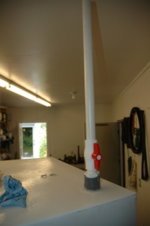Dr Bob and Leverhead or anyone, here is a good question. could you, or would it work heating the kiln by infrared. I still love the crock pot, but it is an interesting if it would work.
Markw
sure. btu's is the answer regardless
Dr Bob and Leverhead or anyone, here is a good question. could you, or would it work heating the kiln by infrared. I still love the crock pot, but it is an interesting if it would work.
Markw
I put a bunch of useful stuff in "Leverhead's Flue Cure experiment " post #79. In one link there, there's a pamphlet that goes into loading density and pressure to get a given airflow. You want at least 1/2 cu/ft of air, per pound of green leaf, per minuet.
thanks mr leverhead. evaporation should be 144 btu per pint/or pound of water. ventilation is the wild card here It is t minus 7 months before the first test run of my chamber. YOU know a lot more about flue curing than me. You done it! I am just talking about it.
seems high. meybe 10% of that would be my guess. 5 cfm per 100# sounds more reasonable. but I am just guessin
In 4 years of growing, I've never weighted any green leaf, so I don't have a clue. What's a big YTB or VBL leaf weight?
In 4 years of growing, I've never weighted any green leaf, so I don't have a clue. What's a big YTB or VBL leaf weight?
based on what's been stated so far, there seems to incentive to recycle hot forced air from the top of the freezer box, back to the bottom, in a manner that would allow moisture to condensate out and drip away. I gotta think about this!
how about an air to air heat exchanger commonly used in new houses. they are great dehumidifiers




 The vent hole in the bottom of the chamber originally had a metal valve which I found not necessary the last photo is the plastic shelf panel on the door just after it was cut off I suspected to find cardboard behind it and I did.
The vent hole in the bottom of the chamber originally had a metal valve which I found not necessary the last photo is the plastic shelf panel on the door just after it was cut off I suspected to find cardboard behind it and I did.
We discuss any variety of tobacco, as well as numerous approaches to growing, harvesting, curing, and finishing your crop. Our members will attempt to provide experience-based answers to your questions.

